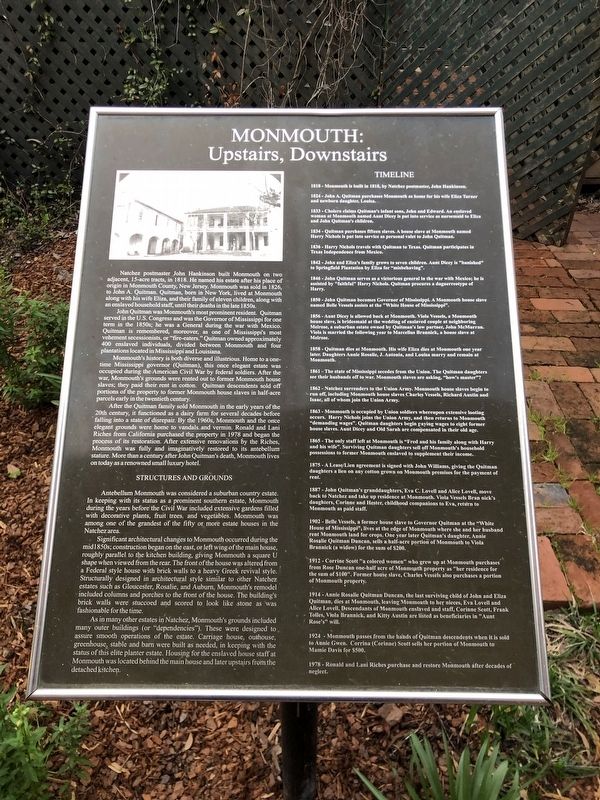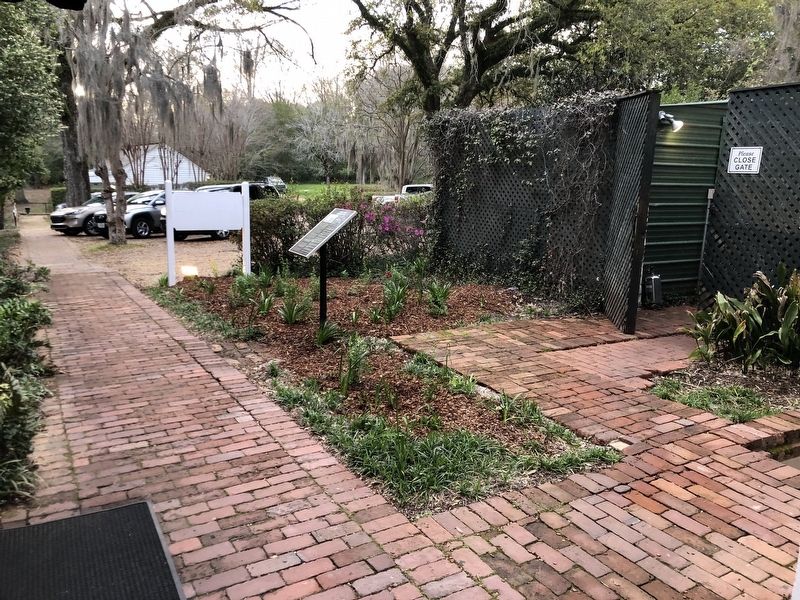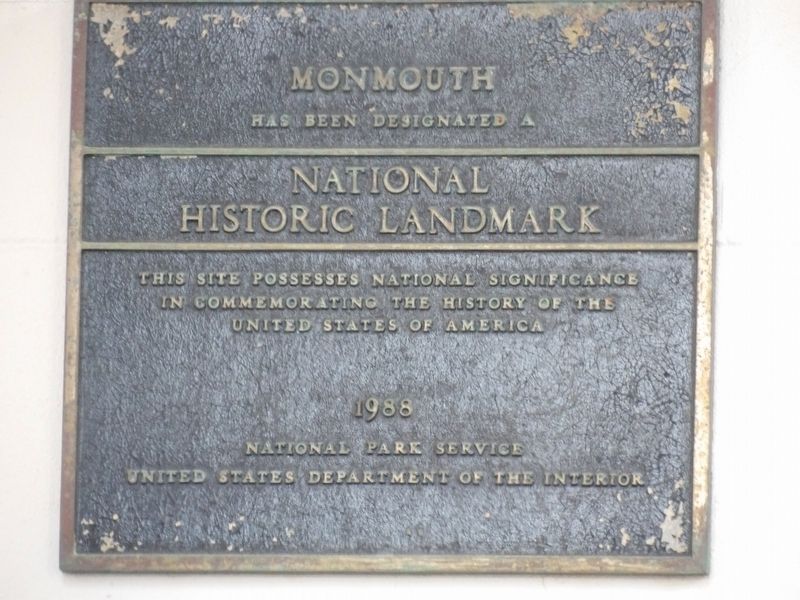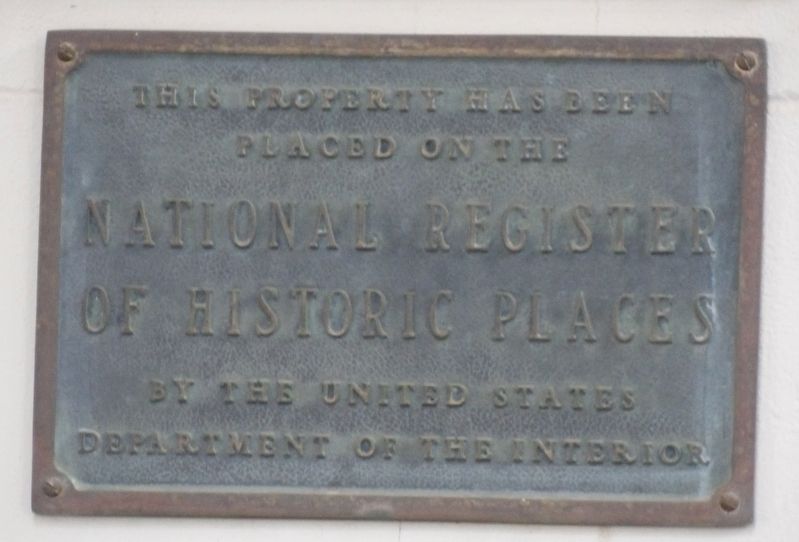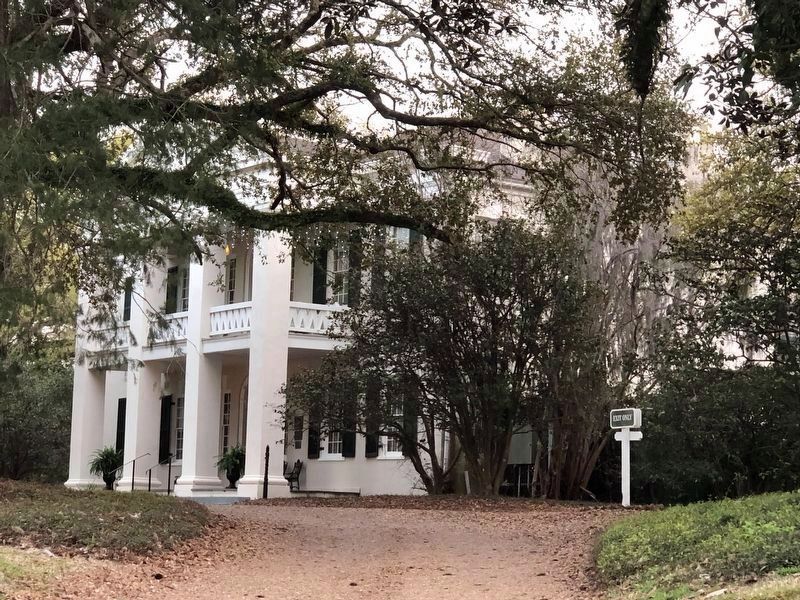Natchez in Adams County, Mississippi — The American South (East South Central)
Monmouth: Upstairs, Downstairs
John Quitman was Monmouth's most prominent resident. Quitman served in the U.S. Congress and was the Governor of Mississippi for one term in the 1850s; he was a General during the war with Mexico. Quitman is remembered, moreover, as one of Mississippi's most vehement secessionists, or “fire-eaters.” Quitman owned approximately 400 enslaved individuals, divided between Monmouth and four plantations located in Mississippi and Louisiana.
Monmouth's history is both diverse and illustrious. Home to a one-time Mississippi governor (Quitman), this once elegant estate was occupied during the American Civil War by federal soldiers. After the war, Monmouth's grounds were rented out to former Monmouth house slaves; they paid their rent in cotton. Quitman descendants sold off portions of the property to former Monmouth house slaves in half-acre parcels in the twentieth century.
After the Quitman family sold Monmouthin the early years of the 20th century, it functioned as a dairy farm for several decades before falling into a state of disrepair. By the 1960s, Monmouth and the once elegant grounds were home to vandals and vermin. Ronald and Lani Riches from California purchased the property in 1978 and began the process of its restoration. After extensive renovations by the Riches, Monmouth was fully and imaginatively restored to its antebellum stature. More than a century after John Quitman's death, Monmouth lives on today as a renowned small luxury hotel.
Structures and Grounds
Antebellum Monmouth was considered a suburban country estate. In keeping with its status as a prominent southern estate, Monmouth during the years before the Civil War included extensive gardens filled with decorative plants, fruit trees, and vegetables. Monmouth was among one of the grandest of the fifty or more estate houses in the Natchez area.
Significant architectural changes to Monmouth occurred during the mid 1850s; construction began on the east, or left wing of the main house, roughly parallel to the kitchen building, giving Monmouth a square U shape when viewed from the rear.The front of the house was altered from a Federal style house with brick walls to a heavy Greek Revival style. Structurally designed in architectural style similar to other Natchez estates such as Gloucester, Rosalie, and Auburn, Monmouth's remodel included columns and porches to the front of the house. The building's brick walls were stuccoed and scored to look like stone as was fashionable for the time.
As in many other estates in Natchez, Monmouth's grounds included many outer buildings (or “dependencies”). These were designed to assure smooth operations of the estate. Carriage house, outhouse, greenhouse, stable and barn were built as needed, in keeping with the status of this elite planter estate. Housing for the enslaved house staff at Monmouth was located behind the main house and later upstairs from the detached kitchen.
Timeline
1818 – Monmouth is built in 1818, by Natchez postmaster, John Hankinson.
1824 – John A. Quitman purchases Monmouth as home for his wife Eliza Turner and newborn daughter, Louisa.
1833 – Cholera claims Quitman's infant sons, John and Edward. An enslaved woman at Monmouth named Aunt Dicey is put into service as nursemaid to Eliza and John Quitman's children.
1834 – Quitman purchases fifteen slaves. A house slave at Monmouth named Harry Nichols is put into service as pers A onal valet to John Quitman.
1836 – Harry Nichols travels with Quitman to Texas. Quitman participates in Texas independence from Mexico.
1842 – John and Eliza's family grows to seven
children. Aunt Dicey is “banished” to Springfield Plantation by Eliza for “misbehaving”.
1846 – John Quitman serves as a victorious general in the war with Mexico; he is assisted by “faithful” Harry Nichols. Quitman procures a daguerreotype of Harry.
1850 – John Quitman becomes Governor of Mississippi. A Monmouth house slave named Belle Vessels assists at the “White House of Mississippi”.
1856 – Aunt Dicey is allowed back at Monmouth. Viola Vessels, a Monmouth house slave, is bridesmaid at the wedding of enslaved couple at neighboring Melrose, a suburban estate owned by Quitman's law partner, John McMurran. Viola is married the following year to Marcellus Brannick, a house slave at Melrose.
1858 – Quitman dies at Monmouth. His wife Eliza dies at Monmouth one year later. Daughters Annie Rosalie, J. Antonia, and Louisa marry and remain at Monmouth.
1861 – The state of Mississippi secedes from the Union. The Quitman daughters see their husbands off to war. Monmouth slaves are asking, “how's master?”
1862 – Natchez surrenders to the Union Army. Monmouth house slaves begin to run off, including Monmouth house slaves Charles Vessels, Richard Austin and Isaac, all of whom join the Union Army.
1863 – Monmouth is occupied by Union soldiers whereupon extensive looting occurs. Harry Nichols joins the Union
Army, and then returns to Monmouth “demanding wages”. Quitman daughters begin paying wages to eight former house slaves. Aunt Dicey and Old Sarah are compensated in their old age.
1865 – The only staff left at Monmouth is “Fred and his family along with Harry and his wife”. Surviving Quitman daughters sell off Monmouth's household possessions to former Monmouth enslaved to supplement their income.
1875 – A lease/lien agreement is signed with John Williams, giving the Quitman daughters a lien on any cotton grown on Monmouth premises for the payment of rent.
1887 – John Quitman's granddaughters, Eva C. Lovell and Alice Lovell, move back to Natchez and take up residence at Monmouth. Viola Vessels Brannick's daughters, Corinne and Hester, childhood companions to Eva, return to Monmouth as paid staff.
1902 – Belle Vessels, a former house slave to Governor Quitman at the “White House of Mississippi”, lives at the edge of Monmouth where she and her husband rent Monmouth land for crops. One year later Quitman's daughter, Annie Rosalie Quitman Duncan, sells a half-acre portion of Monmouth to Viola Brannick (a widow) for the sum of $200.
1912 – Corinne Scott “a colored woman” who grew up at Monmouth purchases from Rose Duncan one-half acre of Monmouth property as “her residence for the sum of $100”. Former house slave, Charles Vessels
also purchases a portion of Monmouth property.
1914 – Annie Rosalie Quitman Duncan, the last surviving child of John and Eliza Quitman, dies at Monmouth, leaving Monmouth to her nieces, Eva Lovell and Alice Lovell. Descendants of Monmouth enslaved and staff, Corinne Scott, Frank Tolles, Viola Brannick, and Kitty Austin are listed as beneficiaries in “Aunt Rose's” will.
1924 – Monmouth passes from the hands of Quitman descendants when it is sold to Annie Gwen. Corrina (Corinne) Scott sells her portion of Monmouth to Mamie Davis for $500.
1978 – Ronald and Lani Riches purchase and restore Monmouth after decades of neglect.
Topics and series. This historical marker is listed in these topic lists: African Americans • Architecture • War, US Civil. In addition, it is included in the National Historic Landmarks, and the National Register of Historic Places series lists. A significant historical year for this entry is 1818.
Location. 31° 33.165′ N, 91° 23.187′ W. Marker is in Natchez, Mississippi, in Adams County. Marker can be reached from John A Quitman Boulevard west of Melrose Avenue, on the left when traveling west. Marker is on brick walkway leading to the hotel office. Touch for map. Marker is at or near this postal address: 1358 John A Quitman Blvd, Natchez MS 39120, United States of America. Touch for directions.
Other nearby markers. At least 8 other markers are within walking distance of this
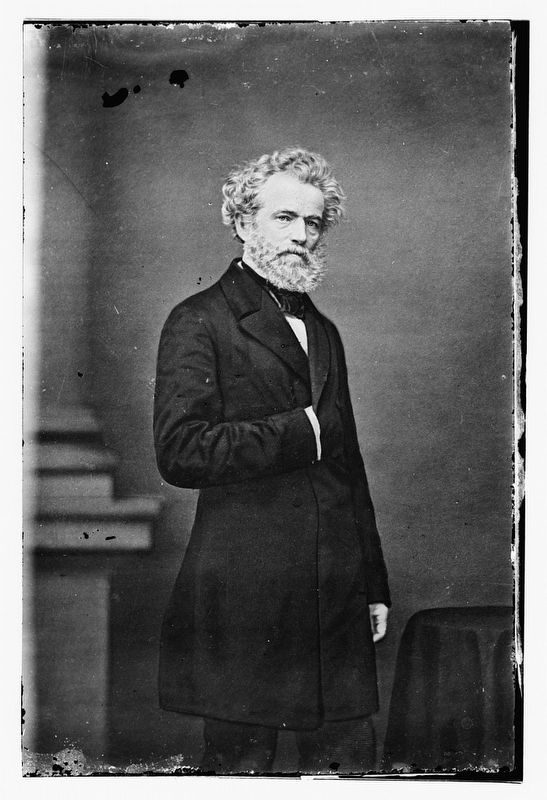
Mathew S. Brady via Library of Congress Prints and Photographs Division (Public Domain), circa 1855
6. John Anthony Quitman (1798-1858)
As president of the Mississippi state senate, he served as acting governor for a month in 1835-36. He was elected governor in his own right in 1849, but resigned just 13 months into his term after he was charged with violating U.S. neutrality laws regarding Cuban independence. The charges were dropped after three separate hung juries.
Also see . . .
1. Monmouth (PDF). National Register of Historic Places (1973) and National Historic Landmark (1988) nominations for the property. (Prepared by Dawn Maddox (Register and Landmark) and Susan Enzweiler (Landmark); via Mississippi Department of Archives and History) (Submitted on March 27, 2024, by Duane and Tracy Marsteller of Murfreesboro, Tennessee.)
2. History. A brief history of the property. (Monmouth Historic Inn and Gardens) (Submitted on March 27, 2024, by Duane and Tracy Marsteller of Murfreesboro, Tennessee.)
3. Tour of Monmouth | Bed & Breakfast in Natchez, MS. Video tour of the house and grounds. (VA Travels, uploaded June 23, 2023) (Submitted on March 27, 2024, by Duane and Tracy Marsteller of Murfreesboro, Tennessee.)
Credits. This page was last revised on March 27, 2024. It was originally submitted on March 27, 2024, by Duane and Tracy Marsteller of Murfreesboro, Tennessee. This page has been viewed 41 times since then. Photos: 1, 2, 3, 4, 5, 6. submitted on March 27, 2024, by Duane and Tracy Marsteller of Murfreesboro, Tennessee.
